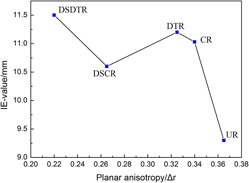Crossref Citations
This article has been cited by the following publications. This list is generated based on data provided by
Crossref.
Sinha, Subhasis
and
Gurao, N. P.
2017.
In-Plane Anisotropy in Mechanical Behavior and Microstructural Evolution of Commercially Pure Titanium in Tensile and Cyclic Loading.
Metallurgical and Materials Transactions A,
Vol. 48,
Issue. 12,
p.
5813.
Li, Cheng-Lin
Won, Jong Woo
Choi, Seong-Woo
Choe, Jung-Ho
Lee, Sangwon
Park, Chan Hee
Yeom, Jong-Taek
and
Hong, Jae Keun
2019.
Simultaneous achievement of equiaxed grain structure and weak texture in pure titanium via selective laser melting and subsequent heat treatment.
Journal of Alloys and Compounds,
Vol. 803,
Issue. ,
p.
407.
Ghosh, Atasi
2019.
Anisotropic tensile and ratcheting behavior of commercially pure titanium processed via cross rolling and annealing.
International Journal of Fatigue,
Vol. 120,
Issue. ,
p.
12.
Zhao, Ding
Fan, Jiangkun
Zhang, Zhixin
Liu, Xudong
Wang, Qingjiang
Chen, Zhiyong
Tang, Bin
Kou, Hongchao
Jia, Shuanxiao
and
Li, Jinshan
2020.
Microstructure and Texture Variations in High Temperature Titanium Alloy Ti65 Sheets with Different Rolling Modes and Heat Treatments.
Materials,
Vol. 13,
Issue. 11,
p.
2466.
Zhou, Guanyu
He, Anrui
Liu, Chao
Chen, Luzhen
Qiang, Yi
and
Liu, Zhengqiao
2022.
Influence of roll diameter configuration of 20 high mill on roll shifting control characteristics of wide titanium strip cold rolling.
Journal of Physics: Conference Series,
Vol. 2383,
Issue. 1,
p.
012070.
Zhou, Guanyu
Li, Hui
He, Anrui
Liu, Chao
Sun, Wenquan
Liu, Zhengqiao
and
Han, Cong
2022.
Simulation and control of high-order flatness defect in rolling wide titanium strip with 20-high mill.
The International Journal of Advanced Manufacturing Technology,
Vol. 120,
Issue. 7-8,
p.
5483.
Gao, Song
He, Tonggui
Li, Qihan
Sun, Yingli
Sang, Ye
Wu, Yuhang
and
Ying, Liang
2022.
Anisotropic behavior and mechanical properties of Ti-6Al-4V alloy in high temperature deformation.
Journal of Materials Science,
Vol. 57,
Issue. 1,
p.
651.
Li, Wei
Li, Songsong
and
Yu, Hui
2022.
Research on the anisotropy of plastic behavior and deformation mechanism of textured pure titanium.
Materials Characterization,
Vol. 194,
Issue. ,
p.
112483.
Li, Wei
Wang, Sanzhong
Huang, Ziteng
Li, Songsong
Huang, Zhaomeng
and
Yu, Hui
2024.
Anisotropic mechanism of cold-rolled pure titanium plate during the two-step tensile process of the variable path.
Materials Science and Engineering: A,
Vol. 906,
Issue. ,
p.
146755.
Guo, Baohong
Wang, Wenshuai
Kong, Bin
Wang, Zhengyu
Kong, Charlie
and
Yu, Hailiang
2024.
Development of Low Anisotropic Commercially Pure Titanium Foils by Asymmetric Rolling and Annealing.
Advanced Engineering Materials,
Vol. 26,
Issue. 11,
Li, Wei
Li, Songsong
Huang, Ziteng
Tang, Guangyao
Zhang, Genmao
and
Yu, Hui
2024.
Research on the anisotropic mechanism of plastic behavior during tensile process of textured pure titanium.
Materials Science and Engineering: A,
Vol. 894,
Issue. ,
p.
146153.
Xiaoyu, Ji
Jianwei, Xu
Hui, Zhang
Jingyao, Du
Weidong, Zeng
and
Wanglei, Wang
2024.
Plastic deformation mechanism of TA1 pure titanium plate using SEM-EBSD in-situ tensile testing.
Materials Science and Engineering: A,
Vol. 908,
Issue. ,
p.
146768.




